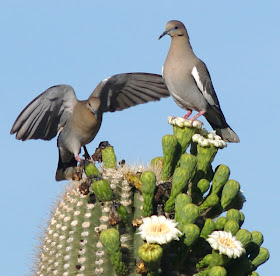 |
| Backyard Saguaros |
 |
| Saguaro Flowers, Watercolor, M. Brummermann 1994 |
In May, Saguaro Cacti form crowns of flower buds on the ends of arms and the main stem. The crown is actually a spiral of more mature buds on the outside, and smaller ones closer to the apical growth spot. The flowers open up a few at a time, so the bloom can go on for several weeks. Any individual flower opens during the night and rarely lasts longer than until noon of the next day. By then the waxy flower starts to wilt. It has almost certainly been visited by several pollinators since Saguaro flowers attract scores of very different animals with great amounts of pollen and nectar,
 |
| Lesser Long-nosed Bat visiting Saguaro flower at night. Photo: Merlin D. Tuttle, Bat Conservation International |
White-winged Doves seem to time their return from southern wintering grounds and their breeding to enjoy both the nectar and soon after the juicy fruits of our Saguaros.
Gila Woodpeckers don't just love the nectar and can often be seen with their faces smeared with pollen, they move right in with the Saguaro, hammering out a nest cavity. The cactus stabilizes it with hard scar tissue, forming a 'saguaro boot'.
The Gilded Flicker, our local form of the Northern Flicker, is another woodpecker that is drawn to blooming saguaros. This photo shows how strong those flowers are, probably a necessary adaptation to bird pollination, especially when other landing options are so very prickly.
Noisy, raucous Cactus Wren families drop in from their nest in a nearby Cholla. Their youngsters often sit begging among the flowers, impatiently demanding to be fed by both parents. This year we have very few nests. I hope they recover soon...
Our breeding pairs of Northern Cardinals and Pyrrhuloxias are unusual visitors, but love an opportunistic slurp of nectar.
 |
| Female Northern Cardinal |
 |
| Male House Finch |
House Finches spend a lot of time at the nectar source, but then they are also great hummingbird feeder connoisseurs.
Aggressive Curve-billed Trashers love the sweets and also the dominating height that the saguaro offers, so the males alternate feeding with territorial singing.
But over the last years the Thrashers got powerful competition as our local Ravens learned to appreciate saguaro nectar. The social Ravens can often be heard telling each other when the sweets are served. Under their assaults, even some of the sturdy Saguaro blossom break off and tumble to the ground.
 |
| Saguaro fruit, Photo by Ned Harris |









Tremendous photos. I particularly like the on e of the bat.
ReplyDeleteAlas, that one isn't mine!
ReplyDeleteFantastic!! Is the fruit edible for us or is it strictly for birds and the like?
ReplyDeleteThe fruit pulp is edible and sweet. The local tribes (Tohon O'odam, Pima) harvest the fruit to make wine for their rain ceremonies. They are the only ones allowed to collect on public lands. At our place, we gladly leave the treats to birds, tortoises and bugs.
ReplyDeleteThese images are all awesome, and it's really amazing, the diversity of life that's connected to saguaros. Excellent post.
ReplyDeleteGreat photos and gorgeous painting! From what I understand, the main pollinators for Saguaros are White-winged Doves, the nectar bats are secondary pollinators.
ReplyDeleteGreat stuff. It's so interesting to see a flicker with its head buried in a giant flower. I mostly see them eating piles of ants, around here. Nice post.
ReplyDeleteWonderful post!
ReplyDeleteStunning photography and I have been to the Saguaro preserve outside Tuscon - and now I know what the fruit looks like!
ReplyDeleteGreat photos! Thanks for sharing.
ReplyDeleteThis comment has been removed by a blog administrator.
ReplyDeleteI love the way you took the pictures on your blog! I am a very BIG fan of animals.
ReplyDeletegreat photos.
ReplyDeleteThe more I read your blog , the more stimulated I become to know more . I am no where near desert so find this all absolutely fascinating and informative .
ReplyDeleteVery cool page. If you want to see more bats stop by my blog http://mostlyphotos.wordpress.com/ and click on the drop down category BATS. The lesser long nosed bats drink from my hummingbird feeders in late summer/early fall, before they migrate back to Mexico.
ReplyDeleteAs a fellow Arizonan (Phoenix), and a botanist, I feel so fortunate to have stumbled across your blog as I prepare to lecture my students tomorrow on pollination. I look forward to perusing your other posts, and seeing more of your beautiful photography and commentary. It looks like we should have gone to Mt. Lemmon a couple weeks ago rather than Oak Creek Canyon- the leaves weren't nearly as beautiful there! Next year...
ReplyDeleteBest wishes, Shannon